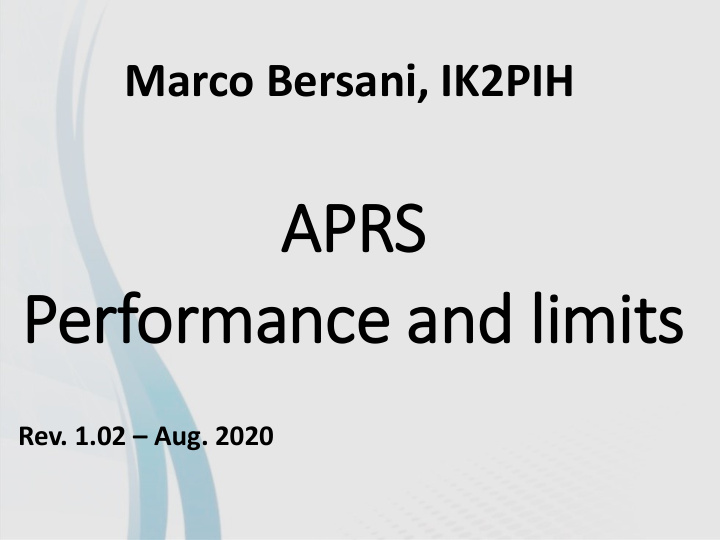



Marco Bersani, IK2PIH APRS Performance and limits Rev. 1.02 – Aug. 2020
Foreword Almost all users have experienced difficulty using the APRS network, due to the congestion that occurs when a fairly limited number of stations send reports and messages. In recent years several strategies have been carried out to improve its performance, but there it's not there yet a quantitative analysis of the efficiency of the system that could serve as a guide to identify the main critical issues and to formulate coherent reorganization proposals. In my paper I have developed a simple performance analysis of the APRS network, which I used to identify the main problems and propose some alternative solutions to the current network.
CHAPTER 1: Introduction Before going into technical issues, I wanted to report some introductory information about the APRS and its operation. This is information that I found on the internet and that I wanted to report to ensure that even those unfamiliar with APRS could read the document. This part of the document, more discursive, has an introductory function.
CHAPTER 2: Access to the shared channel After introducing APRS, I reported some basic information about the radio channel capacity and the two contention access methods used in the APRS network: ALOHA and CSMA. I tried to summarize the information I found on the internet, trying to present the results in the simplest possible way. First of all I have estimated the length of a frame (200 bytes) and the overall capacity of the radio channel, and, in agreement with several authors, I found that at a speed rate of 1200 baud, you will be able to transmit up to 900 APRS frames for a network cycle of 20 minutes.
CHAPTER 2: Access to the shared channel Then I described the ALOHA protocol, that is heavily used in APRS networking. The ALOHA protocol places heavy limitations on overall traffic (max 50%), on throughput (max 18.4%) and on the probability of communication success (36.4%). Only at low network loads does communication become reliable.
CHAPTER 2: Access to the shared channel The CSMA protocol guarantees superior performance for high load, but only if the collision window is small. But there is a problem: in order to be used by all stations, all stations have to listen to each other. In APRS networking is mainly used in terminal-to-digipeater communication.
CHAPTER 3 APRS networks with a single digipeater After describing the protocols used for channel contention access, I imagined a network in which operates only one digipeater. Starting from the expression of the throughput of the aloha protocol, I obtained a table and a graph of the throughput in a network with only one isofrequency digipeater.
CHAPTER 3 APRS networks with a single digipeater I realized that the performance is not much lower than the aloha case without digipeater, especially at low network loads (Smax=15,5% at Gmax=42,2%).
CHAPTER 3 APRS networks with a single digipeater Next I tried to figure out how to improve network performance with a single digipeater using multiple uplink channels, concluding that a single digipeater can serve up to 4 uplink channels at the same downlink rate.
CHAPTER 3 APRS networks with a single digipeater I also wanted to investigate an unorthodox solution such as the use of an analog repeater, concluding that the performance is not much superior to traditional digipeating, especially at low network loads.
CHAPTER 4 Performance and limitations of the APRS network After analyzing networks with a single digipeater I tried to evaluate the impact of several digipeaters on the same frequency. I found that, if multiple repetitions do not occur, neighboring digipeaters quickly saturate the channel with their disturbance, preventing local stations from accessing the network.
CHAPTER 4 Performance and limitations of the APRS network In the case of multiple repetitions, the probability that a frame will be repeated decreases exponentially as the repetitions increase.
CHAPTER 4 Performance and limitations of the APRS network Multiple routes increase the chance of success but also increase network congestion.
CHAPTER 5 New possible arrangements So I realized that the main problem of the APRS network is the presence of isofrequency digipeaters. I have searched, and identified, some configurations that do not suffer from this problem, trying as much as possible not to increase the complexity of the necessary hardware and software.
CHAPTER 5 New possible arrangements The first solution I found is to add a listen-only channel to the existing network. This solution improves local throughput but degrades communication between digipeaters and thus multiple digipeating.
CHAPTER 5 New possible arrangements The best solution I have identified to make a network exclusively via radio is to fragment the network into independent cells operating on different frequencies, connected together by a network of digipeaters operating on another band.
CHAPTER 5 New possible arrangements Another very efficient solution I fond, feasible with current hardware and software, is to use the internet to collect packets by creating an isofrequency diffuse listen only network with receiving only IGATES. Packet transfer takes place via the internet; packets of local interest are retransmitted by transmitting IGATES stations on another frequency, on the same band or on another band.
And that’s all… THANK YOU FOR YOUR ATTENTION
Recommend
More recommend